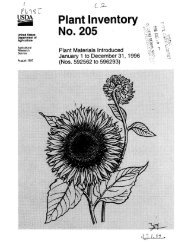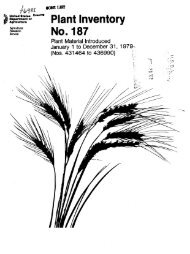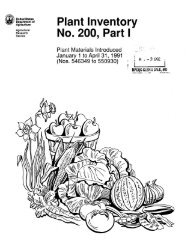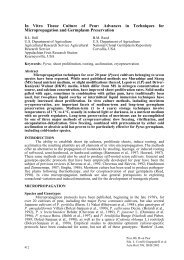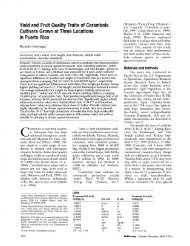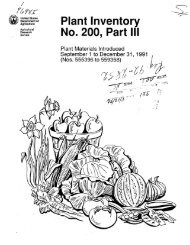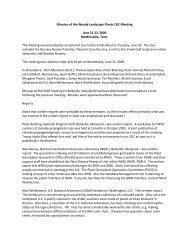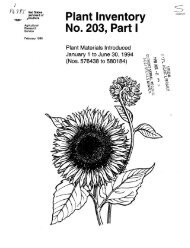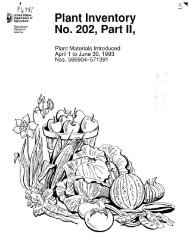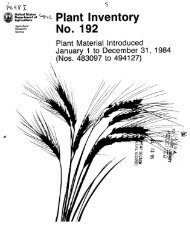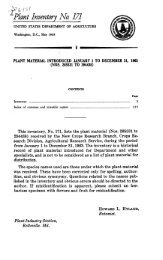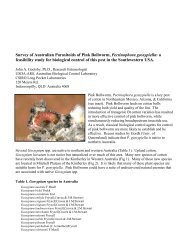Plant Inventory No. 213 - The Germplasm Resources Information ...
Plant Inventory No. 213 - The Germplasm Resources Information ...
Plant Inventory No. 213 - The Germplasm Resources Information ...
- No tags were found...
Create successful ePaper yourself
Turn your PDF publications into a flip-book with our unique Google optimized e-Paper software.
<strong>The</strong> following were developed by Mark Uebersax, Michigan State University, 135Food Science Building, East Lansing, Michigan 48824-1224, United States;George L. Hosfield, USDA, ARS, Michigan State University, Department of Crop& Soil Science, East Lansing, Michigan 48824-1325, United States; Jim D.Kelly, Michigan State University, Department of Crop & Soil Science, 370<strong>Plant</strong> & Soil Sci. Bldg. MSU, East Lansing, Michigan 48824-1325, United States;Gregory M. Varner, Dry Edible Bean Research, Advisory Board, 3066 S.Thomas Road, Saginaw, Michigan 48603, United States; J. Taylor, MichiganState University, Dept. of Crop and Soil Sci., East Lansing, Michigan 48824,United States. Received 08/05/2004.PI 635117. Phaseolus vulgaris L.Cultivar. Pureline. "CONDOR"; MSU #B00101; B00101. CV-233; PVP 200500291.Pedigree - Derived from a cross between black bean cultivars Phantomand Black Jack. Evaluated as MSU #B00101; has been tested for four years(2000-03) over 29 locations and yielded 3100 kg/ha. Exhibits type-IIupright short vine (indeterminate) growth habit combined with resistanceto lodging and plants average 49 cm in height. Is a mid-full season beanmaturing 94 days after planting and has demonstrated good uniformmaturity and dry-down. Possesses the combination of the single dominanthypersensitive I gene which conditions resistance to seed-borne BeanCommon Mosaic Virus (BCMV) but is sensitive to the temperature-insensitivenecrosis-inducingstrains of BCMNV like NL 3 and NL 8. Possesses the Co-1and Co-2 gene combination for resistance to anthracnose and is essentiallyimmune to indigenous rust races prevalent in Michigan. Exhibits improvedlevels of tolerance to white mold and has a similar level of susceptibilityto common bacterial blight as other commercial black bean varieties. Has atypical small opaque black bean seed averaging 23 g/100 seeds and sizeranges from 19-23 g/100 seeds. In canning trials, exhibited no differencesin cooked color, texture, hydration and drained weight ratios, but showedbetter color retention than most commercial black bean varieties.<strong>The</strong> following were developed by Dermot P. Coyne, University of Nebraska,Department of Horticulture, 386 <strong>Plant</strong> Sciences Hall, Lincoln, Nebraska68583-0724, United States; James R. Steadman, University of Nebraska,Department of <strong>Plant</strong> Pathology, 406 <strong>Plant</strong> Science Hall, Lincoln, Nebraska68583, United States; Phillip Miklas, USDA, ARS, Irrigated Agric. Research &Extension Ctr., 24106 <strong>No</strong>rth Bunn Road, Prosser, Washington 99350-9687, UnitedStates; Marcial Pastor-Corrales, USDA, ARS, Vegetable Laboratory, Building010A, Room 240, BARC-West, Beltsville, Maryland 20705-2350, United States; N.Mutlu, University of Nebraska, Department of Biochemistry, Lincoln, Nebraska68588, United States; A.K. Vidaver, University of Nebraska, Dept. of <strong>Plant</strong>Pathology, Lincoln, Nebraska 68583, United States; D. Lindgren, University ofNebraska, Dept. of Agronomy and Horticulture, Lincoln, Nebraska 68583, UnitedStates; J. Reiser, University of Nebraska, Dept. of Agronomy andHorticulture, Lincoln, Nebraska 68583, United States. Received 07/15/2004.PI 635118. Phaseolus vulgaris L.Breeding. ABCP-8. GP-237. Pedigree - Chase *5 / XAN-159. Combines commonbacterial blight resistance from XAN 159 with great northern Montana<strong>No</strong>.5. Possesses Ur-3 for rust resistance and bc-1 2 gene for resistanceto Bean Common Mosaic virus. Seed size is smaller than Chase pinto.111




